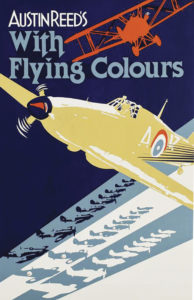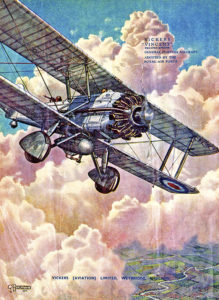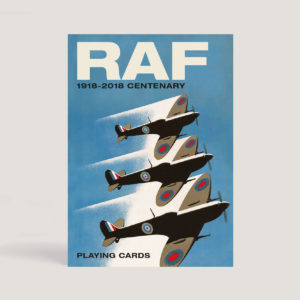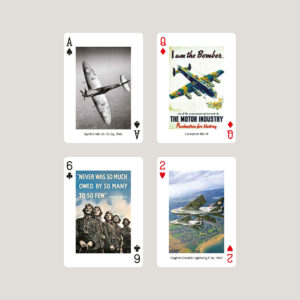THE RAF 1918-2018 CENTENARY
‘If we lose the war in the air we lose the war and lose it quickly.’
FM Bernard Montgomery
If sea power and the might of the Royal Navy were key to victory in WW1, the tactical use of air power came to dominate the Western Front. Without it artillery fired blind and infantry attacked blind. In WW2, as Monty realised, to surrender initiative in the air meant defeat. Air power won the war. The RAF was the most powerful air force in 1918; and in 1940 saved Britain from the Luftwaffe. The RAF then took the war to Germany.
OLDEST AIR FORCE
 It is the world’s oldest independent air force, founded on 1 April 1918, by the amalgamation of the Royal Flying Corps (RFC) and the Royal Naval Air Service (RNAS). The RFC was created in 1912 by Asquith’s government, as a necessary reaction to German militarism; the inspiration being an ex-Argyll officer and Zulu War veteran, Gen David Henderson, its first commander. He developed some of the roles that would be carried on by the RAF: aerial reconnaissance, fighter interception and tactical support. His successor, Hugh Trenchard, who lost a lung in the Boer War, was pivotal. Commanding the RFC from 1915-17, he led it with relentless (if costly) commitment to the offensive, through rough times, through the Fokker scourges of 1915 and ‘Bloody April’ (1917) when the life expectancy of a pilot was 3 weeks. He was the RAF’s first Chief of the Air Staff, a fervent convert to strategic bombing – taking war to the enemy, paralysing communications and civilian morale. As CAS for 10 years after WW1 Trenchard secured the future of the RAF. No easy task.
It is the world’s oldest independent air force, founded on 1 April 1918, by the amalgamation of the Royal Flying Corps (RFC) and the Royal Naval Air Service (RNAS). The RFC was created in 1912 by Asquith’s government, as a necessary reaction to German militarism; the inspiration being an ex-Argyll officer and Zulu War veteran, Gen David Henderson, its first commander. He developed some of the roles that would be carried on by the RAF: aerial reconnaissance, fighter interception and tactical support. His successor, Hugh Trenchard, who lost a lung in the Boer War, was pivotal. Commanding the RFC from 1915-17, he led it with relentless (if costly) commitment to the offensive, through rough times, through the Fokker scourges of 1915 and ‘Bloody April’ (1917) when the life expectancy of a pilot was 3 weeks. He was the RAF’s first Chief of the Air Staff, a fervent convert to strategic bombing – taking war to the enemy, paralysing communications and civilian morale. As CAS for 10 years after WW1 Trenchard secured the future of the RAF. No easy task.
AIRCRAFT DESIGN
In 1918 the RAF was the world’s most powerful air force with 22,000 aircraft, 188 operational squadrons and 291,000 personnel. By 1919, it was reduced to 12 squadrons and 31,500 personnel! It wasn’t until the 1930s that the RAF reached anything like its former strength. 1918-36 was the Golden Age of the biplane, with the Fairy Fox, Hawker Hart and Fury the outstanding examples. Wooden construction, from 1927, was largely superseded by metal tubular airframes. Aircraft design is dictated by your enemy. A ‘General purpose’ plane like the Westland Wapiti was cheap and practical against tribesmen in the Middle East, but useless against Nazi Germany. That was the problem. France was considered the only potential enemy! So RAF bombers didn’t have the range to attack Germany.
RE-ARMAMENT
 In 1936 things changed. The PM, Stanley Baldwin, reviled as fiddling while Hitler expanded, actually oversaw, during times of stringency, a massive rearmament programme. An unprecedented 180 Wellington bombers were ordered – plus 600 Hurricanes and 310 Spitfires, fighters flying at more than 300 mph. Baldwin knew war with Hitler was inevitable. The development of 4-engined bombers with power-operated gun turrets was approved, culminating in the Lancaster, indisputably the RAF’s best WW2 heavy bomber. Crucially, the decade saw technical breakthroughs like retractable undercarriages, stressed-skin construction, the Merlin engine – and radar ground-control, for which Fighter Command’s Hugh Dowding, the victor of the Battle of Britain, must be thanked. Without his refusal to doom his fighter force in a vain attempt to save France in 1940 we should have lost the Battle of Britain. It was still a close run thing, won by Hurricanes and Spitfires, in that order; by brave pilots of many nationalities, by radar, by Goering’s blunders. But not least the RAF prevailed in WW2 because they were given the tools – from a first-line strength of 850 aircraft in 1933, at the outbreak of war the RAF boasted 3550 first-line aircraft. There were many dud designs in WW2 (the Fairey Battle, Defiant, Manchester) but the war spawned the rocket-firing Typhoon, the multi-role Mosquito, and the first jet fighter, the Meteor. By the war’s end the RAF had a total of 55,000 aircraft and more than a million officers and men. And then history repeated itself: the RAF, between 1945 and the Berlin Airlift in 1948, dwindled to below 1000 first-line aircraft and 38,000 regular personnel. But the Airlift, Korea and NATO commitments dramatically reversed the cuts, and the force doubled between 1948 and 1951.
In 1936 things changed. The PM, Stanley Baldwin, reviled as fiddling while Hitler expanded, actually oversaw, during times of stringency, a massive rearmament programme. An unprecedented 180 Wellington bombers were ordered – plus 600 Hurricanes and 310 Spitfires, fighters flying at more than 300 mph. Baldwin knew war with Hitler was inevitable. The development of 4-engined bombers with power-operated gun turrets was approved, culminating in the Lancaster, indisputably the RAF’s best WW2 heavy bomber. Crucially, the decade saw technical breakthroughs like retractable undercarriages, stressed-skin construction, the Merlin engine – and radar ground-control, for which Fighter Command’s Hugh Dowding, the victor of the Battle of Britain, must be thanked. Without his refusal to doom his fighter force in a vain attempt to save France in 1940 we should have lost the Battle of Britain. It was still a close run thing, won by Hurricanes and Spitfires, in that order; by brave pilots of many nationalities, by radar, by Goering’s blunders. But not least the RAF prevailed in WW2 because they were given the tools – from a first-line strength of 850 aircraft in 1933, at the outbreak of war the RAF boasted 3550 first-line aircraft. There were many dud designs in WW2 (the Fairey Battle, Defiant, Manchester) but the war spawned the rocket-firing Typhoon, the multi-role Mosquito, and the first jet fighter, the Meteor. By the war’s end the RAF had a total of 55,000 aircraft and more than a million officers and men. And then history repeated itself: the RAF, between 1945 and the Berlin Airlift in 1948, dwindled to below 1000 first-line aircraft and 38,000 regular personnel. But the Airlift, Korea and NATO commitments dramatically reversed the cuts, and the force doubled between 1948 and 1951.
ICONIC BRITISH AIRCRAFT
The last 60 years have seen Britain’s nuclear strike force, the V bombers come and go – but not without a last hurrah during the Falklands War (1982), when a Vulcan B.2 undertook the longest bombing mission ever to bomb the airfield at Port Stanley. We’ve seen superb home-grown aircraft like the Hunter, Lightning and Harrier – the latter (both RN and RAF) crucial to victory in the Falklands. In the 1991 Gulf War RAF Tornados and Jaguars flew over 2000 missions, and in the 2003 replay Tornados flew nearly 1500. Sadly, we have also seen billions wasted in bungled (often politically motivated) arms procurement. But the drone may change everything. Why be a ‘magnificent man in a flying machine’ if a bloke can do the job with a laptop?


